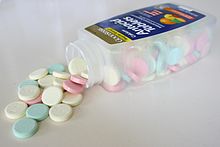Antacid
This article needs additional citations for verification. (December 2007) |

An antacid is any substance, generally a base or basic salt, which counteracts stomach acidity. In other words, antacids are stomach acid neutralizers.
Action mechanism
Antacids perform a neutralization reaction, i.e. they buffer gastric acid, raising the pH to reduce acidity in the stomach. When gastric hydrochloric acid reaches the nerves in the gastrointestinal mucosa, they signal pain to the central nervous system. This happens when these nerves are exposed, as in peptic ulcers. The gastric acid may also reach ulcers in the esophagus or the duodenum.
Other mechanisms may contribute, such as the effect of aluminum ions inhibiting smooth muscle cell contraction and delaying gastric emptying.
Indications

Antacids are taken by mouth to relieve heartburn, the major symptom of gastroesophageal reflux disease, or acid indigestion. Treatment with antacids alone is symptomatic and only justified for minor symptoms. Peptic ulcers may require H2-receptor antagonists or proton pump inhibitors.
The utility of many combinations of antacids is not clear, although the combination of magnesium and aluminium salts may prevent alteration of bowel habits.
Side effects
Excess calcium from supplements, fortified food and high-calcium diets, can cause the milk-alkali syndrome, which has serious toxicity and can be fatal. In 1915, Bertram Sippy introduced the "Sippy regimen" of hourly ingestion of milk and cream, the gradual addition of eggs and cooked cereal, for 10 days, combined with alkaline powders, which provided symptomatic relief for peptic ulcer disease. Over the next several decades, the Sippy regimen resulted in renal failure, alkalosis, and hypercalemia, mostly in men with peptic ulcer disease. These adverse effects were reversed when the regimen stopped, but it was fatal in some patients with protracted vomiting. Milk alkali syndrome declined in men after effective treatments for peptic ulcer disease. But during the past 15 years, it has been reported in women taking calcium supplements above the recommended range of 1200 to 1500 mg daily, for prevention and treatment of osteoporosis, and is exacerbated by dehydration. Calcium has been added to over-the-counter products, which contributes to inadvertent excessive intake.
The New England Journal of Medicine reported a typical case of a woman who arrived in the emergency department vomiting and altered mental status, writhing in pain. She had consumed large quantities of chewable antacid tablets containing calcium carbonate (Tums). She gradually recovered.[1]
Compounds containing calcium may also increase calcium output in the urine, which might be associated with kidney stones.[2] Calcium salts may cause constipation.
Other adverse effects from antacids include:
- Carbonate: regular high doses may cause alkalosis, which in turn may result in altered excretion of other drugs, and kidney stones. A chemical reaction between the carbonate and hydrochloric acid may produce carbon dioxide gas. This causes gastric distension which may not be well tolerated.
- Aluminum hydroxide: may lead to the formation of insoluble aluminium-phosphate-complexes, with a risk for hypophosphatemia and osteomalacia. Although aluminium has a low gastrointestinal absorption, accumulation may occur in the presence of renal insufficiency. Aluminium-containing drugs may cause constipation.
- Magnesium hydroxide: has laxative properties. Magnesium may accumulate in patients with renal failure leading to hypermagnesemia, with cardiovascular and neurological complications. See Milk of magnesia.
- Sodium: increased intake of sodium may be deleterious for arterial hypertension, heart failure and many renal diseases.
Interactions
Altered pH or complex formation may alter the bioavailability of other drugs, such as tetracycline. Urinary excretion of certain drugs may also be affected.
Problems with reduced stomach acidity
Reduced stomach acidity may result in an impaired ability to digest and absorb certain nutrients, such as iron and the B vitamins. Since the low pH of the stomach normally kills ingested bacteria, antacids increase the vulnerability to infection. It could also result in reduced bioavailability of some drugs. For example, the bioavailability of ketoconazole (antifungal) is reduced at high intragastric pH (low acid content).
Drug names
Examples of antacids (brand names may vary in different countries).
- Aluminium hydroxide (Amphojel, AlternaGEL)
- Magnesium hydroxide (Phillips’ Milk of Magnesia)
- Aluminum hydroxide with magnesium hydroxide (Maalox, Mylanta)
- Aluminum carbonate gel (Basaljel)
- Calcium carbonate (Alcalak, TUMS, Quick-Eze, Rennie, Titralac, Rolaids)
- Sodium bicarbonate (Bicarbonate of soda, Alka-Seltzer)
- Hydrotalcite (Mg6Al2(CO3)(OH)16 · 4(H2O); Talcid)
- Bismuth subsalicylate (Pepto-Bismol)
- Magaldrate with Simethicone (Pepsil)
See also
References
- ^ Gabriely, I. (May 1, 2008). "Clinical problem-solving, back to basics". New England Journal of Medicine. 358 (18): 1952–6. doi:10.1056/NEJMcps0706188. PMID 18450607. Retrieved 2008-05-29.
{{cite journal}}: Check date values in:|date=(help); Unknown parameter|coauthors=ignored (|author=suggested) (help) - ^ Cooke, N. (1978). "Antacid-induced osteomalacia and nephrolithiasis". Archives of Internal Medicine. 138 (6): 1007–9. doi:10.1001/archinte.138.6.1007. PMID 646554. Retrieved 2008-05-29.
{{cite journal}}: Unknown parameter|coauthors=ignored (|author=suggested) (help)
